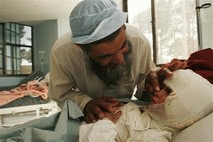By Dave Lindorff
When doctors started reporting that some of the
victims of the US bombing of several villages in Farah Province last
week—an attack that left between 117 and 147 civilians dead, most of
them women and children—were turning up with deep, sharp burns on their
body that “looked like” they’d been caused by white phosphorus, the US
military was quick to deny responsibility.
US officials—who initially denied that the US had even bombed any
civilians in Farah despite overwhelming evidence to the contrary,
including massive craters where houses had once stood—insisted that “no
white phosphorus” was used in the attacks on several villages in Farah.
Official military policy on the use of white phosphorus is to only
use the high-intensity, self-igniting material as a smoke screen during
battles or to illuminate targets, not as a weapon against human
beings—even enemy troops.
Now that policy, and the military’s blanket denial that phosphorus
was used in Farah, have to be challenged, thanks to a recent report
filed from a remote area of Afghanistan by a New York Times reporter.
C.J. Chivers, writing in the May 14 edition of the NY Times,
in an article headlined “Korangal Memo: In Bleak Afghan Outpost, Troops
Slog On,” wrote of how an embattled US Army unit in the Korangal Valley
of Afghanistan, had come under attack following a morning memorial
service for one of its members, Pfc. Richard Demeter, who had been
killed the day before by a mine.
Chivers wrote:
“After the ceremony, the violence resumed. The soldiers
detected a Taliban spotter on a ridge, which was pounded by mortars and
then white phosphorus rounds from a 155 millimeter howitzer.
“What did the insurgents do? When the smoldering subsided, they
attacked from exactly the same spot, shelling the outpost with
30-millimeter grenades and putting the soldiers on notice that the last
display of firepower had little effect. The Americans escalated. An
A-10 aircraft made several gun runs, then dropped a 500-pound bomb.”
It is clear from this passage that the military’s use of the
phosphorus shells had not been for the officially sanctioned purpose of
providing cover. The soldiers had no intention of climbing that hill to
attack the spotter on the ridge themselves. They were trying to destroy
him with shells and bombs. In fact, the last thing they would have
wanted to do was provide the enemy spotter with a smoke cover, which
would have helped him escape, and which also would have hidden him from
the A-10 ground attack planes which had been called in to make gun runs
at his position. Nor was this a case of illuminating the target. The
incident, as Chivers reports, took place in broad daylight.
Clearly then, this article demonstrates that it is routine for US
soldiers to call in phosphorus rounds to attack enemy soldiers, which
is supposed to be against US military policy for this material. Whoever
was manning the howitzer had a stock of the weapons on hand, and was
ready to fire them.
The US initially flatly denied using white phosphorus weapons in
Iraq, when reports first began to come out, including from US troops
themselves, that they had been used extensively against insurgents
defending the city of Fallujah against US Marines in November 2004.
Under mounting pressure, the Pentagon first admitted that it had used
the chemical in Fallujah but only “for illumination.” Later, the
Pentagon added that it had used phosphorus as a “screen” to hide
troops. But finally, in 2005, the Pentagon was forced to admit that it
had also used white phosphorus directly as a weapon against enemy Iraqi
troops in the assault on Fallujah, a city of 300,000 that still held
many civilians.
The same pattern of denial and eventual admission regarding the use
of this controversial and deadly weapon by US forces now seems to be
repeating itself in Afghanistan.
It is odd that given the controversy over the use of white
phosphorus weapons, which result in terrible wounds and eventual death
as phosphorus particles burn their way down through flesh to the bone
and sometimes straight onward through a body, leaving a charred channel
of destruction, the New York Times’ Chivers—or more likely
his editors back in New York?—ignored any mention of the issue while
reporting on the use of the chemical rounds to attack a lone spotter on
the ridge.
Given the current controversy over whether the US used white
phosphorus shells or bombs in Falah Province only days before, it is
hard to understand why the issue wasn’t mentioned in this particular
article. Indeed, in the online version of the story, the word phosphorus is set as a hotlink to an article on the controversy over the battlefield use of phosphorus, indicating that at least someone at the Times has integrity and a good news sense.
As for the US government and the Pentagon, it is clear that they
know the weapon is a vicious and controversial one, and that besides
causing horrific and painful wounds, it is profoundly dangerous for
innocent civilians, particularly when used in town or village settings.
(Note: You can view every article as one long page if you sign up as an Advocate Member, or higher).






